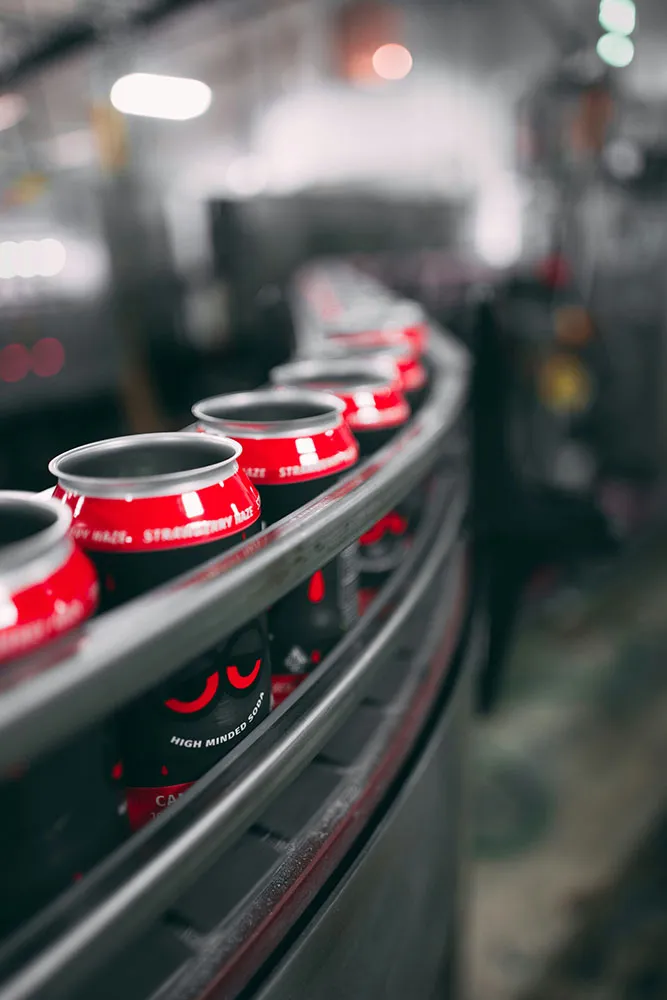Glossary
We know canning can be confusing and overwhelming - especially with so many technical terms, processes, and acronyms to navigate.
Whether you're launching your first ready-to-drink product or scaling up production, this glossary breaks down the most common canning terminology in plain English. From filling lines to filtration, DPG marks to nitrogen dosing, you’ll find clear explanations linked directly to the world of drink canning.
Still have questions? Get in touch below- our team is here to help you make sense of it all.

1 Micron Filtration
A fine filtration step that removes particles larger than one micron. Helps ensure clarity and stability in your canned drink before filling.
CO₂ (Carbon dioxide)
An essential gas used to carbonate drinks like sodas, spritzers and sparkling water. CO₂ also helps preserve freshness by reducing oxygen in the can.
Can format
Refers to the can’s volume and shape — e.g. 250ml slim, 330ml sleek, 500ml standard. Impacts branding, shelf space, and filling equipment.
Carbonisation
The process of adding CO₂ to your drink for fizz. Essential for sparkling water, sodas and some functional drinks before canning.
Co-packing
Partnering with a third-party (like Canable) to handle the canning of your drink, often including sourcing cans, ingredients, and packaging.
Contract filling
An arrangement where we fill and seal your drink into cans under your brand, using our production line and expertise.
DPG mark
A deposit mark required on beverage cans sold in Germany. Canable can help ensure your cans meet DPG requirements for compliance.
Dosing
Controlled addition of ingredients such as sweeteners, acids, or carbonation just before canning — ensures consistency and taste.
Drink development
The R&D stage where recipes are fine-tuned and tested. We collaborate with partners to help you get your formula can-ready.
Filling line
The automated machinery that rinses, fills, seals and sometimes labels cans. The heart of every canning operation.
Filtration
A process to remove solids, yeast or unwanted haze from drinks. Key for product stability and visual clarity in the can.
Functional Drinks
Drinks enhanced with ingredients like vitamins, caffeine, or adaptogens. Special care is taken to ensure stability during canning.
IBC container
A 1,000-litre transport container used to deliver your liquid to our facility — ideal for batch canning.
Mixing
The blending of ingredients or concentrates with water and additives. Must be precise to ensure consistent canning results.
Nitrogen dosing
A drop of liquid nitrogen is added before sealing flat drinks. This pushes out oxygen, extends shelf life and strengthens the can.
Palletisation
Stacking filled cans in a secure pattern on pallets — ready for cold storage or distribution.
Pasteurisation
A heat treatment used to kill microbes and extend shelf life. Common in juice, dairy or low-alcohol drinks before canning.
Preservative
An ingredient added to extend shelf life and reduce spoilage. Often used when pasteurisation isn’t suitable for the drink.
Printed cans
Cans with your design printed directly onto the aluminium. Offers a premium look, usually for larger production runs.
Ready to fill
A drink that’s been fully mixed, filtered and dosed, delivered in IBCs or tanks — prepped and ready for the filling line.
Ready-to-Drink (RTD)
A finished product that’s shelf-stable and consumed straight from the can. Includes energy drinks, iced teas, cocktails, and more.
SO₂ (Sulphur dioxide)
A preservative sometimes used in juice- or wine-based drinks to prevent spoilage. Needs careful handling in the canning process.
Sample filling
A small run of your drink — ideal for tastings, investor meetings, or marketing before scaling up.
Shelf life
The duration a canned drink remains safe and appealing to drink. Influenced by pH, preservative levels, filling method, and packaging integrity.
White label
A drink we can can under your brand name using our base recipe. Fast-track to market without full product development.
pH
A measure of acidity or alkalinity. Important for drink stability, flavour, and determining whether preservatives or pasteurisation are needed.
